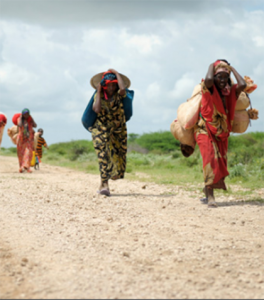Starting a conversation about climate migration
Climate change is dramatically impacting people’s lives across the globe but when natural disasters or droughts force them to leave their countries, they often find closed borders and no assistance.
It is clear climate migrants don’t fit into the widely accepted definitions of refugees and migrants; and that can leave them in limbo.
 Part of the problem is that today’s laws, regulations and international agreements about migrants, asylum-seekers and refugees offer little protection to those forced to flee because of climate-linked crises.
Part of the problem is that today’s laws, regulations and international agreements about migrants, asylum-seekers and refugees offer little protection to those forced to flee because of climate-linked crises.
Currently, national laws focus mainly on violence, conflict or persecution as drivers of forced migration and rarely consider environmental stress.
There is not a single nation whose immigration system currently has environmental criteria for admission.
And international agreements such as the Global Compact for Safe, Orderly and Regular Migration and the Global Compact on Refugees merely mention the impacts of natural disasters and environmental degradation without being legally binding.
But increasingly there are conversations starting about how to identify and help these people.
In a positive move, the Biden administration in the US has started looking at way to help exploring ways to identify and assist people who are displaced by climate change.
The White House recently issued an executive order on ‘Rebuilding and Enhancing Programs to Resettle Refugees and Planning for the Impact of Climate Change on Migration’.
But climate-driven migration is complicated.
Often, the environmental factors associated with climate change are only one factor pushing people to migrate.
And it is not yet known exactly how many climate migrants exist now or how many people will become climate migrants in the future, but current estimates are high.
Researchers say that in the coming years, the rapid pace of climate change combined with a global population nearing eight billion people is likely to create unprecedented stress around the world.
Recent studies show that dry spells and drought are already associated with increased human movement.
And the studies show that the need to escape hazards is replacing the desire to seek economic opportunity as a main driver of international migration.
For instance, a drought displaced hundreds of thousands of people in Ethiopia in 2016. The vast majority stayed within the country’s borders, according to a UNICEF report.
Disasters caused more than 23 million people a year to relocate over the past decade, the majority of them within their own countries, according to the World Meteorological Organization’s State of the Global Climate Report.
And the Intergovernmental Panel on Climate Change predicts this will increase as global warming advances.
The World Bank projects that climate change will drive 143 million people in Latin America, Africa and South Asia alone to leave their homes by 2050. Many come from poor regions that have contributed little to global warming.
Until recently, researchers identified wars and conflict as principal sources of displacement.
Bu beginning in the 1980s, some researchers started using the words “environmental refugee” to refer to people forced to leave their homes because of disruptions related to human or naturally produced environmental events, such as desertification, deforestation, land degradation and rising sea levels.
But the accepted definition of ‘refugee’ doesn’t include climate change.
The UN’s 1951 Refugee Convention defines refugees as people who are forced to flee their homelands because of fear of persecution based on race, religion, nationality, membership in a particular social group or political opinion.
And international law does not clearly define migrants or climate migrants meaning all migrants are subject to the immigration laws of their destination countries – all of which lack environmental criteria for accepting migrants.
But while climate migrants are not legally considered refugees, many are highly vulnerable.
Lacking resources, climate migrants are likely to be poorer than most other international migrants. This may put them at a disadvantage as more countries’ policies scrutinize the economic prospects of immigrants before permitting them entry.
Many observers now believe it’s time for the global community to rethink the role of disasters and climate change in migration; and also to recognise the rights of those displaced by environmental causes.
They say it’s time to reform international and national laws and policies that are out of date with what’s known today about climate change and displacement.
All the evidence says that, whether nations like it or not, the numbers of climate migrant will rise and we all need to be ready.
Read more here:
https://public.wmo.int/en/our-mandate/climate/wmo-statement-state-of-global-climate
https://www.flickr.com/photos/unicefethiopia/31199949331/
https://www.worldbank.org/en/news/feature/2018/03/19/meet-the-human-faces-of-climate-migration












